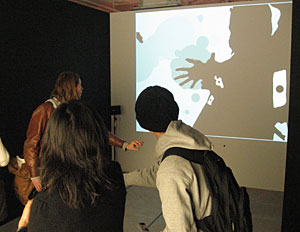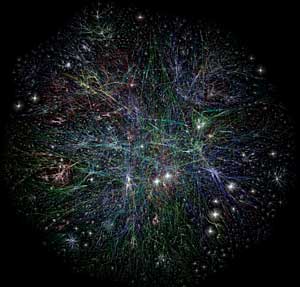At the Museum of Modern Art in New York City through May 12, 2008.
The birth of Bakelite, the first synthetic plastic, revolutionized design in the 20th century. For the first time in human history, things could be created as if from nothing, rather than carved from wood or stone, or fashioned from metal. Within two decades of its 1907 advent, plastic was being used in radios, cars, and telephones; by the century’s end it was in the fabric of the city (in buildings), in the human body (pacemakers), and in outer space (satellites). When Mr. McGuire advised Ben in 1967’s The Graduate, “There’s a great future in plastics. Think about it,” he was not just talking about the material. “Plastic” signified an ethos, a way of life that was fast, cheap, infinitely reproducible, and endlessly variable. Plastic, then, is an analogy for the century that gave us the assembly line, The Work of Art in the Age of Mechanical Reproduction, the Barbie doll, Pop culture, and the mass media.


If the last century was the plastic age, the 21st century will be an elastic epoch. It will not be defined by the substance elastic, but rather by elastic as a metaphor. So goes the argument in the exuberant exhibition at MoMA, Design and the Elastic Mind, up through May 12. Curator Paola Antonelli notes that elasticity is “the byproduct of adaptability plus acceleration.” The elastic mind is eternally, inevitably changing, and designers must try “to make both people and objects perfectly elastic.”
Twenty-first-century consciousness must reckon with exponential advances in everything from information technology to nanotechnology, from interior design to body art. What happens, the show asks, when we have virtual identities, communicate at light-speed, live in 4-D buildings, and are required to internalize a constant and growing deluge of data? What happens when we can engineer organisms and fabricate motors from individual molecules? How are we to understand both the attosecond and the Long Now?
The show’s organizers note that we have “experienced dramatic changes in some of the most established dimensions of human life: time, space, matter, and individuality.” In short, we live in a confusing, exciting time. Design and the Elastic Mind makes sense of some of today’s more bewildering phenomena in a broad yet detailed survey of the technologies that demand an elastic mind.
Upon entering the main gallery, one is immediately struck by Emergent Surface, Chuck Hoberman’s latest experiment in what he calls transformable design. The piece comprises a series of angled columns clad in metal blades that expand or contract in response to the viewer’s movement. As the blades fan out, they meet each other and form a solid, curvilinear plane; when they fold in on themselves, the barrier disappears. It’s one of several works that could see widespread use in the near future, allowing or denying sunlight or sightlines to travel through a building. Another is a series of chairs created with a 3-D printer that uses lasers and polymer resin to create real-world objects from digital blueprints.
The show has a particularly strong section on information design. Pieces like History Flow turn data into a visual display, with changes to the high-volume Wikipedia entries “chocolate” and “abortion” rendered in colored lines. Additionally, there are maps of the volume of phone calls, flights, or Internet activity by region, all of which show the aesthetics of the invisible.
But Design and the Elastic Mind doesn’t get stuck examining metadata, and it never stays too serious for too long. One particularly memorable piece is Shadow Monsters by Phillip Worthington. Tucked away in a corner, the installation appears to be nothing more than a camera and a white wall. Upon entering the camera’s field of view, however, visitors’ larger-than-life shadows are projected onto the wall, augmented with cartoonish, computer-generated embellishments. Shadow puppets grow fangs, hand gestures emit spindly rays, and heads spontaneously sprout horns. Children and adults are uniformly delighted, and while it is possible to see the installation as a commentary on the body mediated, it seems just as good to enjoy the whimsical results.
If the exhibition falters, it is in the more conceptual work, such as Susanna Soares’ Genetic Trace. Here, the artist envisions the possibility of growing new sensory organs as a means of collecting biodata. Soares is tuned in to the advances in bioengineering that make cloning and gene therapy possible, but it’s hard to see how her photographs of people with catlike whiskers fit in with the show. Similarly, Scott Wilson’s iBelieve Lanyard for iPod Shuffle, in which the mp3 player is worn on a cruciform necklace, is essentially a clever one-liner. Both pieces deal with relevant themes, but the Dadas and Situationists were using surrealism and détournement long ago—albeit with different cultural prompts—in much the same way as Soares and Wilson do. In a forward-thinking show, such works seem dated.
These weak elements are few and far between, though. Design and the Elastic Mind is fundamentally strong and serves as a sort of “State of the Contemporary Consciousness” address. The exhibition raises some of the perennial human questions (What is the best way to co-exist? What is happiness? What is true and certain knowledge?). It also poses queries specific to our age (Why do people in a hyper-connected culture feel increasingly isolated?) This is an ambitious, engaging, and successful show that leaves visitors in a state of delightful unrest. It is highly recommended for citizens of the elastic century.






Post a comment to this article
Report Abusive Comment